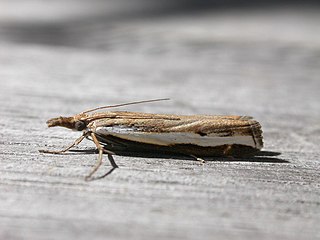
Gelechioidea is the superfamily of moths that contains the case-bearers, twirler moths, and relatives, also simply called curved-horn moths or gelechioid moths. It is a large and poorly understood '"micromoth" superfamily, constituting one of the basal lineages of the Ditrysia.

Keiferia is a genus of moths in the family Gelechiidae.

Tortricopsis uncinella is a moth of the family Oecophoridae. It is found in Australia, including Tasmania. It uses Eucalyptus as the host.

Tortricopsis semijunctella is a moth of the family Oecophoridae. It is found in Australia. The wingspan is about 2 cm (0.79 in).

Tortricopsis pyroptis is a moth of the family Oecophoridae. It is found in Australia.

Udea is a genus of snout moths in the subfamily Spilomelinae of the family Crambidae. The genus was erected by Achille Guenée in 1845. The currently known 216 species are present on all continents except Antarctica. About 41 species are native to Hawaii.

Orocrambus is a genus of moths of the family Crambidae. All species are endemic to New Zealand.

Paradetis is a monotypic moth genus in the family Geometridae. Its only species, Paradetis porphyrias, also known as the orange and purple fern looper, is endemic to New Zealand. The genus and species were first described by Edward Meyrick, the genus in 1885 and the species in 1883. It is found in both the North and South Islands. This species frequents the ferny glens and the banks of mountain streams. It is thought to be widespread in native forests with high rainfall. The larvae likely feeds on the fern Hypolepis millefolium. Adults are commonly on the wing from December to February and fly by the day close to the ground. When at rest the adult has its fore-wings placed slightly backwards, the antennae extended forwards and the end of the abdomen turned upwards. Adults have been trapped via a Mercury-vapour lamp.

The Depressariinae – sometimes spelled "Depressiinae" in error – are a subfamily of moths in the superfamily Gelechioidea. Like their relatives therein, their exact relationships are not yet very well resolved. It has been considered part of family Elachistidae sensu lato or included in an expanded Oecophoridae. In modern classifications they are treated as the distinct gelechioid family Depressariidae.

The Oecophorinae are the nominate subfamily of moths in the concealer moth family (Oecophoridae). They are part of the insufficiently studied superfamily Gelechioidea, and like their relatives, the circumscription of this taxon is disputed.

Tortricopsis aulacois is a moth of the family Oecophoridae. It occurs in Australia and is known from the Australian Capital Territory, New South Wales, Queensland, Victoria, and Tasmania.

Autosticha is a genus of gelechioid moths. It belongs to the subfamily Autostichinae, which is either placed in the concealer moth family (Oecophoridae), or in an expanded Autostichidae. It is the type genus of its subfamily. Originally, this genus was named Automola, but this name properly refers to a fly genus in family Richardiidae.

Xyloryctidae is a family of moths contained within the superfamily Gelechioidea described by Edward Meyrick in 1890. Most genera are found in the Indo-Australian region. While many of these moths are tiny, some members of the family grow to a wingspan of up to 66 mm, making them giants among the micromoths.
Macronemata is a monotypic genus of moths of the family Oecophoridae. The only species is Macronemata elaphia. Both the genus and the sole species were described by Edward Meyrick in 1883.

Glaucocharis interruptus is a moth of the family Crambidae. It was first described by Cajetan von Felder, Rudolf Felder and Alois Friedrich Rogenhofer in 1875. It is endemic to New Zealand and is found in the North and South Islands. This species inhabits native forest and scrub at lowland and subalpine altitudes. It has been observed in scrub in river valleys or in mountain ravines. Larvae of Glaucocharis species feed on mosses and liverworts. Adults can be distinguished from similar appearing species by the Y-shaped reniform. They are on the wing from October to March and it is likely this species has two broods a year.

Epermenia is a genus of moths in the family Epermeniidae. The genus was first described by Jacob Hübner in 1825.

Atomotricha is a genus of moths of the family Oecophoridae. The species in this genus are endemic to New Zealand.

Tingena is a genus of the concealer moth family (Oecophoridae). This genus is endemic to New Zealand.

Trachypepla is a genus of moths of the family Oecophoridae. It was circumscribed in 1883 by Edward Meyrick. The species within this genus are indigenous to Australia and New Zealand.

Tortricopsis is a genus of moths in the subfamily Oecophorinae of the family Oecophoridae. It occurs in Australia.


















